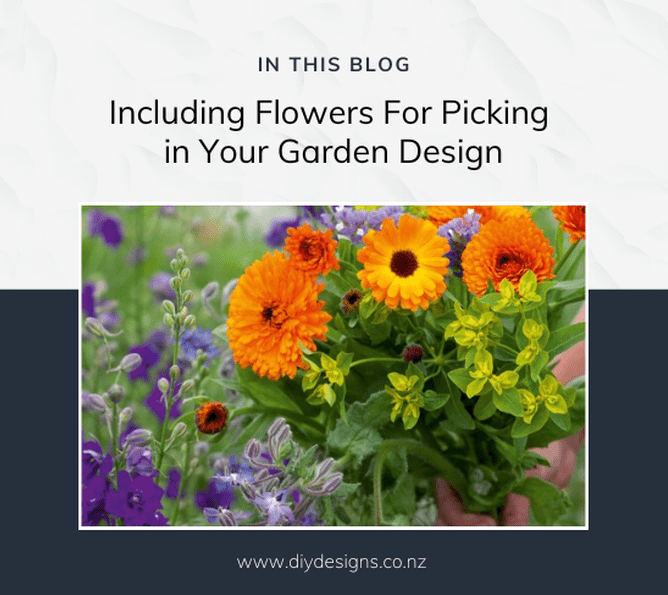Picking Gardens
Picking gardens are popular with my clients because there is a great joy to be had in gathering flowers from your own garden, either to put into a vase or to give as an impromptu gift. When my three daughters were young they were forever raiding my garden for small posies to give to their teachers or friend. 'Tussie mussies' were the name we gave them, a hangover from my floristry days when we used to bundle up all our offcuts into colourful little mixed bunches tied off with ribbon.
In the garden I had at that time, sometimes the flowering pickings were so slim that even as an ex-florist, it was pretty challenging!
Plus, let's face it, if you’ve waited all season for those gorgeous lilies or iris to flower then chopping them down to give away, or admire for just a few days is a vase, feels like a pretty big sacrifice!
The trick to creating picking gardens is to include flowering plants in your garden design in such a way that there is an abundance of flowering plants throughout the year, and also in a way that means cutting blooms doesn’t detract from your floriferous garden aesthetic.
Here’s my top 5 tips to include flowers for picking in your garden design:
1. Plant a Specific Picking Garden Bed
True picking gardens, also known as cutting gardens, are where flowering plants, especially feature blooms, are grown for the sole purpose of cutting. They tend to be a little eclectic in their design as a ‘the more the merrier’ approach is needed. So if that will ruin your garden aesthetics, choose a tucked away spot or, consider a more relaxed spot in the garden such as on the periphery of your vegetable garden, or next to a playhouse. Just make sure it will capture plenty of sun as the most free-flowering plants are typically sun lovers. Plant in rows for easy harvesting and go crazy with bulbs that will multiply over time such as lillies (a mix of asiatic, casablanca and Christmas), Iris (Japanese and Dutch) plus jonquils and daffodils.
2. Sow a Wildflower Berm
If you are tired of mowing your pointless front berm, then consider using that wasted space to sow a wildflower garden. Growing from seed is best and there are lots of specific mixes available from garden centres and nurseries. Whether you are looking for a cottage garden effect, bee or butterfly-attracting plants, or a hot-colour mix, you are sure to find one suitable for your growing conditions and purpose. Keep safety in mind when planting out a berm by ensuring that traffic and pedestrian view lines remain clear and that visibility splays out of your driveway are not obstructed by your flower-filled paradise.
3. Create a Cottage Garden
Brimming with a mix of gorgeous, pickable plants, creating an informal cottage-style garden is a great way to ensure a steady stream of pickable flowers. If space is tight, consider ditching the front lawn and mass plant an abundance of old-fashioned favourites instead. Include a mix of large feature flowers such as such as roses, dahlia and delphiniums, along with small free-flowering filler flowers such as perennials and annuals. Include plants such as salvia, penstemon, larkspur and lavender. If you like a more structured look, add in some large leaf foliage plants or clipped forms to offset the floral abundance, or border your beds with low-clipped hedges.
4. Pretty up the Productive Garden
Adding flowering plants to your productive gardens or vegetable garden area not only pretties it up and gives it a lift visually, it will also help attract pollinators. Sunflowers are an obvious picking choice but smaller picks such as calendula, coreopsis and marigolds also look lovely massed in a small jar or vase and make perfect companions for edibles. If you include fruit trees in your productive garden areas (or as part of your wider garden scheme) they can provide sprays of blossom or fragrant twigs of citrus blossom.
5. Add Stars to the Shrubbery
Shrubs and trees are a great source of large, dramatic flowers and foliage, particularly in the winter when many perennial gardens are looking a tad empty. With so many cultivars to choose from florist's favourites such as magnolia, camellia and gardenia can be worked into most garden themes. Fragrant sprigs of daphne or osmanthus make these leafy shrubs worthy of a spot in your garden, and if you are gardening in the shade, choose from the myriad of hydrangea cultivars. Shrubs and trees also provide important foliage and fillers, which you can use to bulk out your bouquets and vases, so consider this when choosing hedging plants and screening shrubs.

